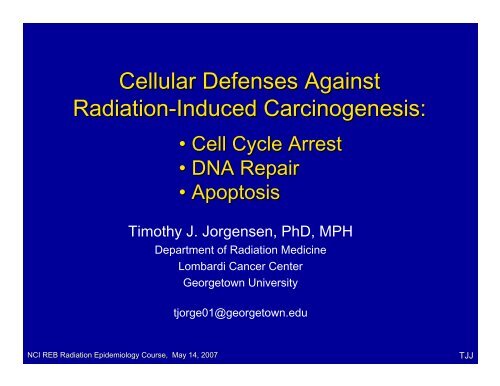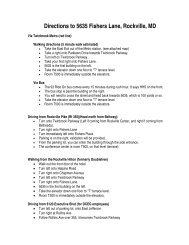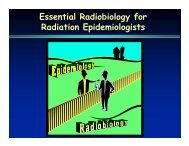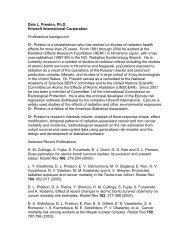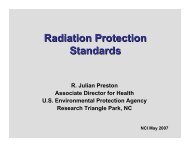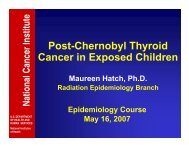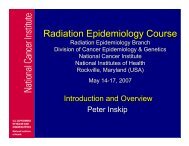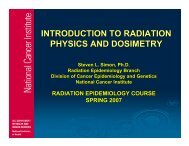Cellular Defenses Against Radiation-Induced Carcinogenesis:
Cellular Defenses Against Radiation-Induced Carcinogenesis:
Cellular Defenses Against Radiation-Induced Carcinogenesis:
Create successful ePaper yourself
Turn your PDF publications into a flip-book with our unique Google optimized e-Paper software.
<strong>Cellular</strong> <strong>Defenses</strong> <strong>Against</strong><br />
<strong>Radiation</strong>-<strong>Induced</strong> <strong>Carcinogenesis</strong>:<br />
• Cell Cycle Arrest<br />
• DNA Repair<br />
• Apoptosis<br />
Timothy J. Jorgensen, PhD, MPH<br />
Department of <strong>Radiation</strong> Medicine<br />
Lombardi Cancer Center<br />
Georgetown University<br />
tjorge01@georgetown.edu<br />
NCI REB <strong>Radiation</strong> Epidemiology Course, May 14, 2007<br />
TJJ
CELL CYCLE ARREST<br />
DNA REPAIR<br />
APOPTOSIS<br />
NCI REB <strong>Radiation</strong> Epidemiology Course, May 14, 2007<br />
TJJ
GOALS:<br />
• Provide an overall description of how these three<br />
processes work to inhibit transformation.<br />
• Describe how they are mechanistically connected.<br />
• Show how they interact with radiation damage.<br />
• Discuss molecular epidemiology implications for<br />
gene-environment interaction studies.<br />
• Review epidemiological biases and confounding<br />
issues.<br />
NCI REB <strong>Radiation</strong> Epidemiology Course, May 14, 2007<br />
TJJ
DNA damage is thought to be the primary<br />
mechanism by which radiation transforms cells.<br />
Yet, only a small number of cells are actually<br />
transformed.<br />
How are most cells protecting themselves from<br />
DNA damage-mediated transformation<br />
NCI REB <strong>Radiation</strong> Epidemiology Course, May 14, 2007<br />
TJJ
NCI REB <strong>Radiation</strong> Epidemiology Course, May 14, 2007<br />
TJJ
NCI REB <strong>Radiation</strong> Epidemiology Course, May 14, 2007<br />
TJJ
NCI REB <strong>Radiation</strong> Epidemiology Course, May 14, 2007<br />
TJJ
CELL CYCLE<br />
ARREST<br />
NCI REB <strong>Radiation</strong> Epidemiology Course, May 14, 2007<br />
TJJ
Cancer cells “evolve” into a highly unstable phenotype:<br />
Loss of contact inhibition<br />
Loss of anchorage dependence<br />
Tumorogenesis<br />
Metastasis<br />
NCI REB <strong>Radiation</strong> Epidemiology Course, May 14, 2007<br />
TJJ
• The ability to undergo successive genetic<br />
change suggests that a loss of genetic<br />
stability is an early event in carcinogenesis.<br />
• Cell cycle control via cell cycle checkpoints, is<br />
thought to be a major mechanism by which<br />
cells maintain genetic stability.<br />
NCI REB <strong>Radiation</strong> Epidemiology Course, May 14, 2007<br />
TJJ
WHY CHECKPOINTS<br />
Fidelity of cell division is dependent upon faithful<br />
copying and segregation of genetic material, both<br />
spatially and temporally. That is, the ordered<br />
sequence of specific events is essential to proper<br />
execution of the task.<br />
For this reason, cells have developed checkpoints<br />
that insure that the previous replication step is<br />
complete before the next step begins.<br />
NCI REB <strong>Radiation</strong> Epidemiology Course, May 14, 2007<br />
TJJ
HOW DO CHECKPOINTS WORK<br />
• Checkpoints are governed by phosphorylation<br />
activity of a group of proteins called CDK (cyclin<br />
dependent kinases).<br />
• The CDKs are active only in complexes that contain<br />
at least one other protein, called a “cyclin”.<br />
• Changes in the cyclin and kinase components of the<br />
complexes are the “switches” that control and<br />
regulate progression through the cell cycle.<br />
• In this model, a cohort of proteins required for<br />
progression of a particular phase are activated (or<br />
inactivated) by phosphorylation of the cyclin/CDK<br />
complexes.<br />
NCI REB <strong>Radiation</strong> Epidemiology Course, May 14, 2007<br />
TJJ
NCI REB <strong>Radiation</strong> Epidemiology Course, May 14, 2007<br />
TJJ
NCI REB <strong>Radiation</strong> Epidemiology Course, May 14, 2007<br />
TJJ
NCI REB <strong>Radiation</strong> Epidemiology Course, May 14, 2007<br />
TJJ
In yeast, only a single CDK is used by a sequence of<br />
different cyclins that are briefly transcribed and then<br />
quickly degraded at specific points in the cell cycle. The<br />
cyclin is, therefore, the important regulatory component<br />
determining the specificity of the CDK.<br />
In mammalian cells, multiple CDKs appear to<br />
be involved:<br />
CDK4 functions early (in response to growth factors)<br />
CDK2 is required to start DNA replication<br />
CDC2 is essential for mitosis<br />
Cyclin<br />
D<br />
E and/or A<br />
A and B<br />
NCI REB <strong>Radiation</strong> Epidemiology Course, May 14, 2007<br />
TJJ
Cyclin/CDK complexes seem to be regulated by a<br />
variety of feedback mechanism, both positive and<br />
negative, that include:<br />
• Transcription of cyclin<br />
• Degradation of cyclin<br />
• Phosphorylation of CDKs<br />
Negative feedback occurs during development,<br />
differentiation, and senescence. It probably acts to<br />
stop cell cycle progression when the integrity of the<br />
genome has been compromised for some reason.<br />
NCI REB <strong>Radiation</strong> Epidemiology Course, May 14, 2007<br />
TJJ
WHAT EFFECT DOES DNA DAMAGE HAVE<br />
• A major challenge to genetic integrity is physical damage to<br />
DNA, and it appears that cells have developed strong negative<br />
feedbacks in response to DNA damage.<br />
• Suppression of cell cycle works in concert with DNA repair to:<br />
1. Allow time for DNA repair<br />
2. To stimulate DNA repair activity<br />
• Feedback mechanisms are mediated via intermediate proteins<br />
that detect or respond to either the damaging agent or the<br />
damage itself and act on the cyclin/CDK complexes to suppress<br />
their ability to promote progression to the next stage of the cell<br />
cycle. There are probably many checkpoints throughout the cell<br />
and only the major ones are known.<br />
NCI REB <strong>Radiation</strong> Epidemiology Course, May 14, 2007<br />
TJJ
• At least two checkpoints are responsive to DNA damage:<br />
1. G1-S transition<br />
2. G2-M transition<br />
• In mammalian cells the G1-S checkpoint is best understood.<br />
NCI REB <strong>Radiation</strong> Epidemiology Course, May 14, 2007<br />
TJJ
G1-S S checkpoint:<br />
An early response to DNA damage is induction of<br />
p53 by a post-translational mechanism.<br />
P53 then transcriptionally activates a set of p53<br />
dependent genes:<br />
• Gadd45 is a growth arrest DNA damage dependent<br />
gene<br />
• p21 inhibits the kinase activity of multiple cyclin/CDK<br />
complexes.<br />
The major consequence of p53 induction is either<br />
arrest in G1 or apoptosis.<br />
NCI REB <strong>Radiation</strong> Epidemiology Course, May 14, 2007<br />
TJJ
DO DEFECTIVE CHECKPOINTS CAUSE CANCER<br />
Evidence suggests that the loss of the G1-S checkpoint<br />
can result in cancer:<br />
1. p53 is commonly mutated in a wide variety of<br />
cancers.<br />
2. p53 mutant cells are typically highly aneuploid and<br />
have gene amplifications.<br />
3. Some cancer viruses express proteins that bind to<br />
p53.<br />
4. Cells from A-T patients (cancer prone) have<br />
abnormal induction of p53.<br />
NCI REB <strong>Radiation</strong> Epidemiology Course, May 14, 2007<br />
TJJ
Evidence for the role of the G2-M checkpoint in<br />
cancer is weaker:<br />
1. Cells from A-T patients undergo reduced G2-M<br />
arrest in response to DNA damage.<br />
2. Cancer cell lines often have reduced G2-M<br />
arrest.<br />
3. Some cancer cells have altered expression of<br />
cyclins A, B, and CDC2.<br />
NCI REB <strong>Radiation</strong> Epidemiology Course, May 14, 2007<br />
TJJ
<strong>Radiation</strong>-<strong>Induced</strong> G2 delay in lymphoblasts may<br />
be a good biomarker for lung cancer<br />
Controls<br />
Cases<br />
NCI REB <strong>Radiation</strong> Epidemiology Zhou Course, May et al. 14, 2007<br />
Cancer Res. 61:7819, 2001<br />
TJJ
APOPTOSIS<br />
NCI REB <strong>Radiation</strong> Epidemiology Course, May 14, 2007<br />
TJJ
NCI REB <strong>Radiation</strong> Epidemiology Course, May 14, 2007<br />
TJJ
APOPTOSIS<br />
Science 285:898, 1999<br />
NCI REB <strong>Radiation</strong> Epidemiology Course, May 14, 2007<br />
TJJ
Rothkamm and Lobrick, PNAS, 2003<br />
NCI REB <strong>Radiation</strong> Epidemiology Course, May 14, 2007<br />
TJJ
DNA REPAIR<br />
NCI REB <strong>Radiation</strong> Epidemiology Course, May 14, 2007<br />
TJJ
Somatic Mutation and Cancer<br />
Environmental carcinogens<br />
DNA Damage<br />
DNA Repair<br />
Mutatagenesis<br />
<strong>Carcinogenesis</strong><br />
NCI REB <strong>Radiation</strong> Epidemiology Course, May 14, 2007<br />
TJJ
Major classes of DNA damage:<br />
Strand breaks<br />
Base damage<br />
Crosslinks<br />
DSB<br />
SSB<br />
Oxydative<br />
Alkylation<br />
Bulk adducts<br />
Interstrand<br />
Intrastrand<br />
DNA-protein<br />
NCI REB <strong>Radiation</strong> Epidemiology Course, May 14, 2007<br />
TJJ
Major DNA repair pathways:<br />
• Non-homologous end joining (NHEJ)<br />
• Base Excision Repair (BER)<br />
• Nucleotide Excision Repair (NER)<br />
• Homologous Recombination Repair<br />
• Illegitimate Recombination Repair<br />
• Mismatch Repair (MMR)<br />
NCI REB <strong>Radiation</strong> Epidemiology Course, May 14, 2007<br />
TJJ
254 nm<br />
>320 nm<br />
NCI REB <strong>Radiation</strong> Epidemiology Course, May 14, 2007<br />
TJJ
NCI REB <strong>Radiation</strong> Epidemiology Course, May 14, 2007<br />
TJJ
UV<br />
PRL<br />
PRL<br />
UV<br />
UV (24 J/m2)<br />
UV + PRL<br />
PRL + UV<br />
untreated<br />
Fish with thyroid tumors<br />
Number Percent<br />
40/40 100%<br />
0/22 0%<br />
38/40 95%<br />
0/22 0%<br />
NCI REB <strong>Radiation</strong> Epidemiology Course, May 14, 2007<br />
TJJ
NCI REB <strong>Radiation</strong> Epidemiology Course, May 14, 2007<br />
TJJ
NCI REB <strong>Radiation</strong> Epidemiology Course, May 14, 2007<br />
TJJ
“… the failure of DNA repair in the<br />
skin must be related to carcinogenesis.”<br />
-- James E. Cleaver<br />
NCI REB <strong>Radiation</strong> Epidemiology Course, May 14, 2007<br />
TJJ
Nucleotide Excision Repair (NER)<br />
NCI REB <strong>Radiation</strong> Epidemiology Course, May 14, 2007<br />
TJJ
T. Lindahl and R.D. Wood, Science 286, 1897, 1999<br />
NCI REB <strong>Radiation</strong> Epidemiology Course, May 14, 2007<br />
TJJ
NCI REB <strong>Radiation</strong> Epidemiology Course, May 14, 2007<br />
TJJ
NER PATHWAY GENES<br />
GENE ALIASES DESCRIPTION<br />
CCNH<br />
cyclin H<br />
CDK7 cyclin-dependent kinase 7<br />
CETN2 CALT CEN2 caltractin isoform 1 (Centrin 2)<br />
CKN1 CSA Cockayne syndrome 1 (classical)<br />
DDB1 damage-specific DNA binding protein 1<br />
DDB2 damage-specific DNA binding protein 2<br />
ERCC1 UV20 excision repair cross-complementing group 1<br />
ERCC2 XPD excision repair cross-complementing group 2<br />
ERCC3 XPB BTF2 GTF2H RAD25 TFIIH excision repair cross-complementing group 3<br />
ERCC4 XPF RAD1 excision repair cross-complementing group 4<br />
ERCC5 XPG UVDR XPGC ERCM2 excision repair cross-complementing group 5<br />
ERCC6 CSB CKN2 COFS RAD26 excision repair cross-complementing group 6<br />
GTF2H1 general transcription factor IIH, polypeptide 1<br />
GTF2H2 general transcription factor IIH, polypeptide 2<br />
GTF2H3 general transcription factor IIH, polypeptide 3<br />
GTF2H4 general transcription factor IIH, polypeptide 4<br />
LIG1<br />
ligase I, DNA, ATP-dependent<br />
MNAT1<br />
menage a trois 1 (CAK assembly factor)<br />
RAD23A HHR23A RAD23 homolog A<br />
RAD23B HHR23B P58 HR23B RAD23 homolog B<br />
RPA1<br />
replication protein A1<br />
RPA2<br />
replication protein A2<br />
RPA3<br />
replication protein A3<br />
XAB2 HCNP HCNP protein; XPA-binding protein 2<br />
XPA XP1 XPAC XP complementation group A<br />
NCI REB <strong>Radiation</strong> Epidemiology Course, May 14, 2007<br />
TJJ
Mismatch Repair<br />
NCI REB <strong>Radiation</strong> Epidemiology Course, May 14, 2007<br />
TJJ
Mismatch repair associated tumors in mouse models<br />
NCI REB <strong>Radiation</strong> Epidemiology Course, May 14, 2007<br />
TJJ
Base Excision<br />
Repair<br />
NCI REB <strong>Radiation</strong> Epidemiology Course, May 14, 2007<br />
TJJ
Non-Homologous End Joining (NHEJ)<br />
NCI REB <strong>Radiation</strong> Epidemiology Course, May 14, 2007<br />
TJJ
Homologous Recombination<br />
NCI REB <strong>Radiation</strong> Epidemiology Course, May 14, 2007<br />
TJJ
Illegitimate Recombination<br />
NCI REB <strong>Radiation</strong> Epidemiology Course, May 14, 2007<br />
TJJ
DNA REPAIR PATHWAYS<br />
ERROR-FREE<br />
PATHWAYS<br />
base excision repair<br />
nucleotide excision repair<br />
mismatch repair<br />
ERROR-PRONE<br />
PATHWAYS<br />
NHEJ<br />
illegitimate recombination<br />
glycosylases<br />
AP-endonucleses<br />
dRp-ases<br />
DNA polymerases<br />
ligases<br />
DNA-PKcs<br />
Ku<br />
NCI REB <strong>Radiation</strong> Epidemiology Course, May 14, 2007<br />
TJJ
TARGET THEORY<br />
NCI REB <strong>Radiation</strong> Epidemiology Course, May 14, 2007<br />
TJJ
NORMAL CELL<br />
CANCER<br />
CELL DEATH<br />
NCI REB <strong>Radiation</strong> Epidemiology Course, May 14, 2007<br />
TJJ
A-T CELL<br />
CANCER<br />
CELL DEATH<br />
NCI REB <strong>Radiation</strong> Epidemiology Course, May 14, 2007<br />
TJJ
Are radiation sensitivity genes and radiation carcinogenesis<br />
genes the same<br />
• Several radiation sensitivity genes are known (e.g. ATM), but generally<br />
these genes confer sensitivity specifically to radiation-induced killing.<br />
• <strong>Cellular</strong> radiosensitivity genes are potential radiation carcinogenesis genes,<br />
but association with increased cancer risk has not been established.<br />
• The problem may be that sensitivity to radiation lethality and radiation<br />
carcinogenesis may be competing phenotypes.<br />
DEATH<br />
CANCER<br />
NCI REB <strong>Radiation</strong> Epidemiology Course, May 14, 2007<br />
TJJ
OTHER TARGET QUESTIONS:<br />
• If DNA repair deficiency predisposes to radiation<br />
induced cancer, then what are the mutated target<br />
genes that cause cellular transformation<br />
• What is the mechanism of transformation<br />
NCI REB <strong>Radiation</strong> Epidemiology Course, May 14, 2007<br />
TJJ
Li-Fraumeni<br />
Syndrome<br />
• Caused by a germline mutation in p53 gene (TP53)<br />
• Characterized by the occurrence of early onset:<br />
• sarcomas<br />
• breast cancer<br />
• brain tumours<br />
• leukemia<br />
• adrenocortical tumors<br />
NCI REB <strong>Radiation</strong> Epidemiology Course, May 14, 2007<br />
TJJ
Mutations in Chk2 produce the Li-Fraumeni<br />
phenotype<br />
Family pedigree with proband (1265, arrow) diagnosed with both breast cancer and sarcoma. A<br />
heterozygous germline mutation in CHK2 is accompanied by loss of the wild type CHK2 allele<br />
in breast cancer of the proband. The mutant R145W allele encodes and unstable protein.<br />
(S.B. Lee et al. Cancer Res. 61: 8062, 2001)<br />
NCI REB <strong>Radiation</strong> Epidemiology Course, May 14, 2007<br />
TJJ
With all of these well-defined pathways and wellcharacterized<br />
genes that are known to be involved<br />
in resisting radiation damage to cells, it is tempting<br />
to speculate that different forms of the genes from<br />
these pathways might alter individual risk of<br />
radiation-induced cancer.<br />
We know this to be true in the special case of<br />
individuals with genetic diseases that have<br />
functional mutations in both alleles. But is it true for<br />
heterozygotes of mutated genes, or normal<br />
individuals with polymorphic forms of these genes<br />
How do we go about answering this fundamental<br />
question<br />
NCI REB <strong>Radiation</strong> Epidemiology Course, May 14, 2007<br />
TJJ
CASE STUDY:<br />
Finding Molecular Targets for<br />
<strong>Radiation</strong>-<strong>Induced</strong><br />
Basal Cell Carcinoma<br />
NCI REB <strong>Radiation</strong> Epidemiology Course, May 14, 2007<br />
TJJ
Gene-Environmental Interactions in Cancer<br />
Which environmental carcinogens<br />
Which cancers<br />
Which genes<br />
NCI REB <strong>Radiation</strong> Epidemiology Course, May 14, 2007<br />
TJJ
NCI REB <strong>Radiation</strong> Epidemiology Course, May 14, 2007<br />
TJJ
NCI REB <strong>Radiation</strong> Epidemiology Course, May 14, 2007<br />
TJJ
NCI REB <strong>Radiation</strong> Epidemiology Course, May 14, 2007<br />
TJJ
Problems for Epidemiology of BCC<br />
BCC and SCC are not in most cancer registries<br />
because:<br />
• Large numbers to follow<br />
• Multiple lesions per individual<br />
• Multiple lesions diagnosed simultaneously<br />
•High cure rate<br />
Nevertheless, it is estimated that the combined incidence of<br />
BCC and SCC is nearly equal to the incidence of all other<br />
cancers combined.<br />
NCI REB <strong>Radiation</strong> Epidemiology Course, May 14, 2007<br />
TJJ
Environmental Causes of BCC<br />
• UV radiation<br />
• Ionizing radiation<br />
• Arsenic<br />
NCI REB <strong>Radiation</strong> Epidemiology Course, May 14, 2007<br />
TJJ
Bazex-Dupre-Christol Syndrome<br />
• Skin disorder with high incidence of BCC on face and hands<br />
• BCC onset from 15-25 years of age<br />
• X-linked transmission<br />
• Gene unknown<br />
Rombo Syndrome<br />
• Similar to Bazex, but with male to male transmission<br />
• Gene unknown<br />
Xeroderma Pigmentosum<br />
• High incidence in BCC, SCC, and melanoma<br />
• Mean age of cancer onset is 8 years<br />
• Defect in one of 7 nucleotide excision repair genes<br />
Gorlin Syndrome<br />
• Nevoid basal cell carcinoma syndrome (NBCC)<br />
• 90% of patients have at least one BCC by age 40<br />
• Germline mutation in the PTCH gene<br />
NCI REB <strong>Radiation</strong> Epidemiology Course, May 14, 2007<br />
TJJ
UV DAMAGE TO DNA<br />
NCI REB <strong>Radiation</strong> Epidemiology Course, May 14, 2007<br />
TJJ
Nucleotide Excision Repair (NER)<br />
NCI REB <strong>Radiation</strong> Epidemiology Course, May 14, 2007<br />
TJJ
NER PATHWAY GENES<br />
GENE ALIASES DESCRIPTION<br />
CCNH<br />
cyclin H<br />
CDK7 cyclin-dependent kinase 7<br />
CETN2 CALT CEN2 caltractin isoform 1 (Centrin 2)<br />
CKN1 CSA Cockayne syndrome 1 (classical)<br />
DDB1 damage-specific DNA binding protein 1<br />
DDB2 damage-specific DNA binding protein 2<br />
ERCC1 UV20 excision repair cross-complementing group 1<br />
ERCC2 XPD excision repair cross-complementing group 2<br />
ERCC3 XPB BTF2 GTF2H RAD25 TFIIH excision repair cross-complementing group 3<br />
ERCC4 XPF RAD1 excision repair cross-complementing group 4<br />
ERCC5 XPG UVDR XPGC ERCM2 excision repair cross-complementing group 5<br />
ERCC6 CSB CKN2 COFS RAD26 excision repair cross-complementing group 6<br />
GTF2H1 general transcription factor IIH, polypeptide 1<br />
GTF2H2 general transcription factor IIH, polypeptide 2<br />
GTF2H3 general transcription factor IIH, polypeptide 3<br />
GTF2H4 general transcription factor IIH, polypeptide 4<br />
LIG1<br />
ligase I, DNA, ATP-dependent<br />
MNAT1<br />
menage a trois 1 (CAK assembly factor)<br />
RAD23A HHR23A RAD23 homolog A<br />
RAD23B HHR23B P58 HR23B RAD23 homolog B<br />
RPA1<br />
replication protein A1<br />
RPA2<br />
replication protein A2<br />
RPA3<br />
replication protein A3<br />
XAB2 HCNP HCNP protein; XPA-binding protein 2<br />
XPA XP1 XPAC XP complementation group A<br />
NCI REB <strong>Radiation</strong> Epidemiology Course, May 14, 2007<br />
TJJ
QUESTIONS:<br />
• If NER repair deficiency predisposes to radiation<br />
induced BCC, then what are the mutated target genes<br />
that cause cellular transformation<br />
• What is the mechanism of transformation<br />
NCI REB <strong>Radiation</strong> Epidemiology Course, May 14, 2007<br />
TJJ
Skin cancers have unique p53 mutations:<br />
NCI DE REB Brash <strong>Radiation</strong> Epidemiology et al. PNAS Course, May 88:10124, 14, 2007<br />
1991<br />
TJJ
Mutation spectrum matched UV mutagenesis and differs from<br />
mutations in internal tumors:<br />
NCI DE REB Brash <strong>Radiation</strong> Epidemiology et al. PNAS Course, May 88:10124, 14, 2007<br />
1991<br />
TJJ
For BCC, PTCH may be even a bigger target than p53<br />
p53<br />
PTCH<br />
J Dermatol Sci 29:1, 2002<br />
NCI REB <strong>Radiation</strong> Epidemiology Course, May 14, 2007<br />
TJJ
p53<br />
PTCH<br />
NCI REB <strong>Radiation</strong> Epidemiology Course, May 14, 2007<br />
TJJ
Gorlin Syndrome<br />
• Nevoid basal cell carcinoma syndrome (NBCCS)<br />
• Autosomal dominant disease with high penetrance<br />
• Accounts for ~0.5% of all BCC cases (probably much higher<br />
percentage of early onset BCC)<br />
• 20% of the patients also develop medulloblastoma<br />
and other cancers.<br />
• Patients treated with radiotherapy develop large numbers<br />
of basal cell carcinomas in the radiation field.<br />
• Gene responsible is the human homolog of the “Patched”<br />
gene (PTCH) in Drosophila, and may be a tumor suppressor<br />
in mammalian cells.<br />
• Patched is a transmembrane signal transduction protein upstream<br />
of sonic hedgehog, Smoothened, and the proto-oncogene Gli1.<br />
• PTCH heterozygote mice have enhanced sensitivity to radiationinduced<br />
teratogenesis.<br />
NCI REB <strong>Radiation</strong> Epidemiology Course, May 14, 2007<br />
TJJ
• Very early onset<br />
NCI REB <strong>Radiation</strong> Epidemiology Course, May 14, 2007<br />
• Many primary tumors<br />
ICRP Publication 79, 1998<br />
TJJ
Verónica Martín, Graciela Carrillo, Carlos Torroja and Isabel Guerrero. The sterol-sensing<br />
domain of Patched protein seems to control Smoothened activity through Patched vesicular<br />
trafficking, Curr. Biol. 11: 601-607 (2001).<br />
NCI REB <strong>Radiation</strong> Epidemiology Course, May 14, 2007<br />
TJJ
Hh and Wnt<br />
Pathways<br />
Taipale J and Beachy PA<br />
Nature 411:349-54 (2001)<br />
NCI REB <strong>Radiation</strong> Epidemiology Course, May 14, 2007<br />
TJJ
Taipale J and Beachy PA Nature 411:349-54 (2001)<br />
NCI REB <strong>Radiation</strong> Epidemiology Course, May 14, 2007<br />
TJJ
HEDGEHOG PATHWAY<br />
Overexpression oncogenic in mouse skin<br />
N<br />
*<br />
Shh<br />
*<br />
Cholesterol<br />
Genetic disease<br />
mimics Shh mutation<br />
Shh<br />
Cholesterol<br />
PTCH<br />
Shh<br />
Defective in Gorlin’s Syndrome*<br />
Mutation oncogenic<br />
in mouse skin<br />
*<br />
SMOOTHENED<br />
SUFU<br />
First cloned as an oncogene *<br />
from glioblastoma<br />
Gli1<br />
Gli3<br />
NCI REB <strong>Radiation</strong> Epidemiology Course, May 14, 2007<br />
TJJ
PTCH may<br />
play a role<br />
in cell cycle<br />
regulation<br />
EMBO J. 20:2214, 2001<br />
NCI REB <strong>Radiation</strong> Epidemiology Course, May 14, 2007<br />
TJJ
F.M. Watt’s Model for Skin Cell Differentiation<br />
•Beta-Catenin levels<br />
determine commitment<br />
to differentiation<br />
pathway.<br />
•Sonic Hedgehog<br />
drives hair follicle<br />
lineage.<br />
•BCC tumors are<br />
believed to derive from<br />
this lineage.<br />
Tumor types:<br />
sebaceous<br />
tumors<br />
BCC<br />
SCC<br />
adapted from Niemann et al. PNAS 100:11873, 2003<br />
NCI REB <strong>Radiation</strong> Epidemiology Course, May 14, 2007<br />
TJJ
NCI REB <strong>Radiation</strong> Epidemiology Course, Guerrero May 14, 2007<br />
et al., Science 301:774, 2003<br />
TJJ
Fan et al. J. Cell Biol, 147:71, 1999<br />
NCI REB <strong>Radiation</strong> Epidemiology Course, May 14, 2007<br />
TJJ
Aszterbaum et al. Nature Med. 5:1285, 1999<br />
NCI REB <strong>Radiation</strong> Epidemiology Course, May 14, 2007<br />
TJJ
Dahmane et al. Nature 389: 876, 1997<br />
NCI REB <strong>Radiation</strong> Epidemiology Course, May 14, 2007<br />
TJJ
Shh, PTCH, and SUFU mutations produce<br />
developmental defects, suggesting gene<br />
dosage effects.<br />
NCI REB <strong>Radiation</strong> Epidemiology Course, May 14, 2007<br />
TJJ
Holoprosencephaly<br />
J.E. Ming et al. Mol. Med. Today 4:343, 1998<br />
NCI REB <strong>Radiation</strong> Epidemiology Course, May 14, 2007<br />
TJJ
Thomas et al., J. Postgrad Med. 49:173, 2003<br />
NCI REB <strong>Radiation</strong> Epidemiology Course, May 14, 2007<br />
TJJ
NCI REB <strong>Radiation</strong> Epidemiology Course, May 14, 2007<br />
TJJ
NCI REB <strong>Radiation</strong> Epidemiology Course, May 14, J.E. 2007<br />
Ming et al. Mol. Med. Today 4:343, 1998<br />
TJJ
Cyclopamine<br />
NCI REB <strong>Radiation</strong> Epidemiology Course, May 14, 2007<br />
TJJ
Veratrum californicum<br />
(corn lily)<br />
NCI REB <strong>Radiation</strong> Epidemiology Course, May 14, 2007<br />
TJJ
Cholesterol<br />
Cyclopamine<br />
Edison and Muenke Congenital Abnormalities 43:1, 2003<br />
NCI REB <strong>Radiation</strong> Epidemiology Course, May 14, 2007<br />
TJJ
Frank-Kamenetsky et al. J. Biol. 1:10, 2002<br />
NCI REB <strong>Radiation</strong> Epidemiology Course, May 14, 2007<br />
TJJ
Nature 422:313, 2003<br />
Cyclopamine inhibits<br />
growth of tumors with<br />
activated hedgehog<br />
pathways.<br />
NCI REB <strong>Radiation</strong> Epidemiology Course, May 14, 2007<br />
TJJ
CONFOUNDERS:<br />
AGE<br />
SKIN COLOR<br />
DOSE<br />
NCI REB <strong>Radiation</strong> Epidemiology Course, May 14, 2007<br />
TJJ
AGE<br />
The Bare Facts of Aging<br />
Photograph by Sarah Leen<br />
NCI REB <strong>Radiation</strong> Epidemiology Course, May 14, 2007<br />
National Geographic Magazine, November 2002<br />
TJJ
• A disease of accelerated aging.<br />
• Gene (WRN) encodes a helicase (RecQ) involved in DNA repair and<br />
DNA replication.<br />
• Normal aging may involve decrease in DNA repair.<br />
• Scleroderma-like skin changes.<br />
WERNER SYNDROME<br />
• Increased incidence of malignancy: GI tract, lung, kidney, ovary, breast.<br />
14 y 48 y<br />
NCI REB <strong>Radiation</strong> Epidemiology Course, May 14, 2007<br />
TJJ
Age and DNA Repair Capacity (DRC) in BCC<br />
NCI REB <strong>Radiation</strong> Epidemiology Course, May 14, 2007<br />
Wei et al. PNAS 90:1614, 1993<br />
TJJ
Age-Dependent Reactive Oxygen Species (ROS)<br />
ROS generation w<br />
4.5<br />
4.2<br />
4<br />
3.5<br />
3<br />
2.7<br />
2.5<br />
2<br />
1.5<br />
2.0<br />
2.3<br />
1<br />
0.5<br />
0<br />
8 24 48 80<br />
Age (wee<br />
Exp Dematology 12:655, 2003<br />
NCI REB <strong>Radiation</strong> Epidemiology Course, May 14, 2007<br />
TJJ
Aging<br />
DNA repair genes<br />
DNA repair<br />
DNA Damage<br />
(cancer)<br />
The multiple pathways through which aging can interact<br />
in the gene to cancer pathway, makes aging an important<br />
confounder that needs to be carefully adjusted for.<br />
Epidemiological limitation is that we can only adjust for<br />
chronological age and not biological age.<br />
NCI REB <strong>Radiation</strong> Epidemiology Course, May 14, 2007<br />
TJJ
SKIN<br />
COLOR<br />
GENETICS<br />
NCI REB <strong>Radiation</strong> Epidemiology Course, May 14, 2007<br />
TJJ
Skin color is a powerful risk modifier:<br />
Whites have ~100-fold higher BCC incidence than blacks.<br />
Whites have ~10-fold higher SCC incidence than blacks.<br />
NCI REB <strong>Radiation</strong> Epidemiology Course, May 14, 2007<br />
TJJ
Am J Epidemiol 155: 614, 2002<br />
Melanin density is<br />
inversely related to<br />
skin cancer risk.<br />
NCI REB <strong>Radiation</strong> Epidemiology Course, May 14, 2007<br />
TJJ
SNOW GOOSE<br />
NCI REB <strong>Radiation</strong> Epidemiology Course, May 14, 2007<br />
TJJ
Melanocortin 1 Receptor gene<br />
(MC1R)<br />
NCI REB <strong>Radiation</strong> Epidemiology Course, May 14, 2007<br />
TJJ
NCI REB <strong>Radiation</strong> Epidemiology Course, May 14, 2007<br />
TJJ
SKIN COLOR GEOGRAPHY<br />
Photograph by Sarah<br />
Leen;<br />
map created by George<br />
Chaplin<br />
Australian Aborigine<br />
Glenys Martin holds a<br />
map of human skin<br />
colors based on global<br />
ultraviolet radiation<br />
intensity and<br />
precipitation levels.<br />
National<br />
Geographic<br />
Magazine,<br />
November 2002<br />
NCI REB <strong>Radiation</strong> Epidemiology Course, May 14, 2007<br />
TJJ
PROBLEM:<br />
Sun burn and skin cancer are not thought to affect<br />
reproductive success. So what is the evolutionary<br />
pressure selecting for skin color correlation with UV<br />
exposure<br />
Competing Nutrient Hypothesis of Skin Color<br />
Folate<br />
UV<br />
Previtamin D<br />
Jablonski and Chaplin, J Human Evolution 39:57, 2000<br />
NCI REB <strong>Radiation</strong> Epidemiology Course, May 14, 2007<br />
TJJ
DOSE<br />
NCI REB <strong>Radiation</strong> Epidemiology Course, May 14, 2007<br />
TJJ
Altered Epidemiologic Paradigm:<br />
<strong>Radiation</strong> Dose is NOT the Exposure<br />
Genotype = Exposure<br />
Dose = Effect Modifier or Confounder<br />
NCI REB <strong>Radiation</strong> Epidemiology Course, May 14, 2007<br />
TJJ
National Geographic Magazine<br />
April 2007<br />
Overexpressed in BCC<br />
Protein Keratin 14 (KTR14 gene)<br />
NCI REB <strong>Radiation</strong> Epidemiology Course, May 14, 2007<br />
TJJ
GENES<br />
Aging genes<br />
(I.e. non-DNA repair)<br />
CONFOUNDING<br />
VARIABLES<br />
Age<br />
DNA repair genes<br />
DNA repair<br />
DNA Damage<br />
Skin color genes<br />
(Ethnicity or SES)<br />
UV Dose<br />
Skin Color<br />
NCI REB <strong>Radiation</strong> Epidemiology Course, May 14, 2007<br />
TJJ
Aging genes<br />
(I.e. non-DNA repair)<br />
Age<br />
DNA repair genes<br />
DNA repair<br />
DNA Damage<br />
Skin color genes<br />
(Ethnicity or SES)<br />
UV Dose<br />
Skin Color<br />
NCI REB <strong>Radiation</strong> Epidemiology Course, May 14, 2007<br />
TJJ
Aging genes<br />
(I.e. non-DNA repair)<br />
Age<br />
DNA repair genes<br />
DNA repair<br />
DNA Damage<br />
Skin color genes<br />
(Ethnicity or SES)<br />
UV Dose<br />
Skin Color<br />
NCI REB <strong>Radiation</strong> Epidemiology Course, May 14, 2007<br />
TJJ
RR for XP patients by age<br />
8000<br />
8000<br />
7000<br />
6000<br />
5000<br />
4900<br />
RR<br />
4000<br />
3000<br />
2000<br />
1000<br />
0<br />
BCC itself is a risk factor for other cancers<br />
Cancer 100:1, 2004<br />
NCI REB <strong>Radiation</strong> Epidemiology Course, May 14, 2007<br />
TJJ
<strong>Radiation</strong> as a Model Carcinogen:<br />
• Known to be a human carcinogen for almost 100 years.<br />
• Strong epidemiological evidence shows clear dose response.<br />
• High dose risks known with reasonable precision/accuracy.<br />
• Low dose risks are highly uncertain and model dependent.<br />
• All tissues believed to be at risk.<br />
• Some risk incurred at all dose levels (i.e. no threshold).<br />
• Dosimetry is very good. (What is a “pack-year” anyway!)<br />
• All individuals in a population are exposed to some degree.<br />
• Range of exposures within a population can be quite broad.<br />
• Direct interaction with the target of carcinogenesis, and confines<br />
the problem to downstream of DNA damage.<br />
• Major cellular protective molecular mechanisms known in some<br />
degree of detail (e.g. DNA repair and cell cycle arrest).<br />
• <strong>Radiation</strong> is a relatively weak carcinogen (room for genetic enhancement).<br />
NCI REB <strong>Radiation</strong> Epidemiology Course, May 14, 2007<br />
TJJ
TAKE-HOME MESSAGE<br />
• <strong>Radiation</strong> has many advantages as a model carcinogen for<br />
studying gene-environment (G-E) interactions in cancer.<br />
• BCC has many advantages as a cancer model for G-E<br />
interactions.<br />
• DNA repair genes in the NER pathway are prime<br />
candidates for G-E interaction in BCC.<br />
• Genes in Hedgehog pathway may also be very important to BCC<br />
etiology.<br />
• Cell cycle, apoptosis, and other pathways may play a role in<br />
BCC, but the evidence is weaker.<br />
• Care must be taken to avoid confounding genes, such aging and<br />
skin color related genes.<br />
• Dose should be viewed as a powerful affect modifier and<br />
potential confounder.<br />
• There is probably a strong multiplicative interaction between age of<br />
onset and BCC RR, that needs to be adjusted for.<br />
• Genes involved in BCC are probably important for other cancers as well.<br />
NCI REB <strong>Radiation</strong> Epidemiology Course, May 14, 2007<br />
TJJ


